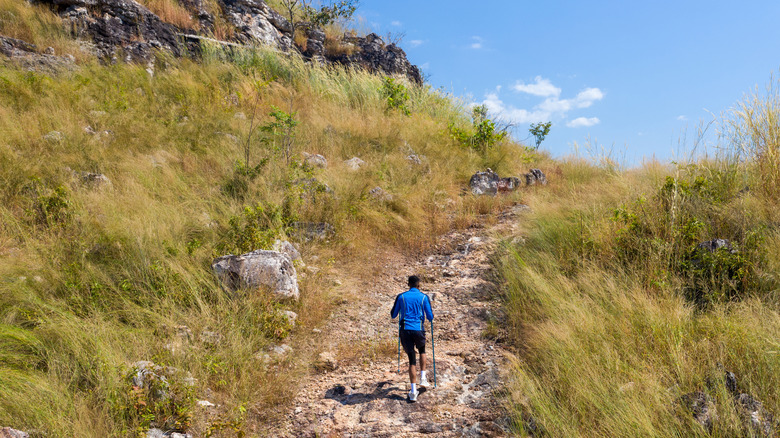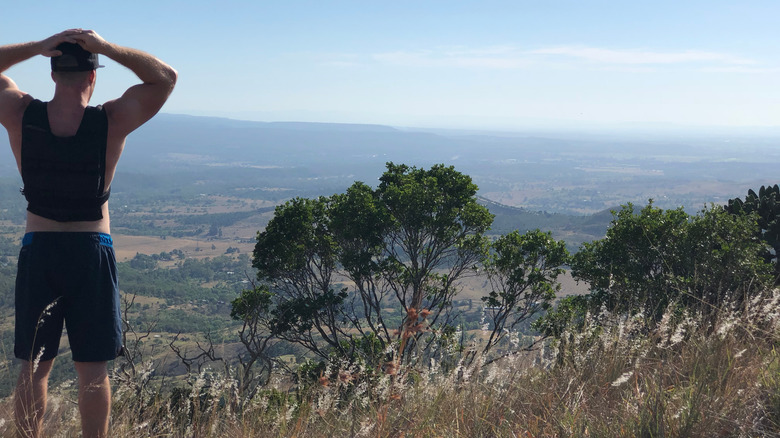How To Physically Prepare For A Long-Distance Hike
We may receive a commission on purchases made from links.
As long-distance hiking has grown in popularity in recent years, more and more hikers are attempting trails such as the Appalachian Trail and Pacific Crest Trail. In fact, the P.C.T. has seen the number of hiking permits issued quadruple over the past decade. While attempting such hikes may hold appeal for various reasons, not getting in proper physical shape before attempting one of these trails is a hiking mistake to avoid.
While there is no definite length that defines a long-distance hike, the majority of these trails take days or even weeks to complete. Additionally, a good many of these trails are thru-hikes, a hiking term you should know, which means you go from point A to point B to complete the trail as opposed to returning to the same starting point. So, building up adequate endurance to continue hiking to the completion point is an absolute must.
It is not just distance that defines many long-distance hikes. Several of these trails are also among the most dangerous places in the world to hike due to steep inclines, rugged terrain, high elevation, and various other factors. As a result, endurance alone is not enough to successfully complete these hikes. You will also need to improve your flexibility so your body can move at odd angles if needed and increase your strength in order to be able to move up and down grades and inclines and over boulders, logs, or other obstructions. So, beyond just doing the research to find the best long-distance and thru-hiking trails, it is important you know how to physically prepare for a long-distance hike.
Increase your strength, endurance, and flexibility
When setting a workout routine to get in shape for a long-distance hike, it is important to start well in advance and increase your training load gradually to avoid overtraining, which will set you back. The central pillar of this training regiment should be aerobic or cardio work to increase your endurance. This can be done through a variety of different activities, such as running, walking, cycling, or swimming. REI recommends at least three or four aerobic/cardio days per week leading up to your long-distance hike as the minimum needed to build adequate endurance.
Building strength is another important aspect when it comes to physically preparing for a long-distance hike. While you do need to increase your overall body strength, the focus should be on your lower body, as your legs are what you will be relying on to get up and down the trail. Resistance movements such as squats and lunges are key to this process. Additionally, plyometric movements such as box jumps or box step-ups can improve your leg strength and give you the explosive strength needed to hike up steep inclines or over obstructions.
You will also need to strengthen your core and increase your balance and flexibility. Good examples of exercises to strengthen your core include planks, Russian twists, mountain climbers, and leg raises. To improve your balance, you can do movements such as single-leg squats without weights or single-leg balance beam stands on a block, balance board, or other object. When it comes to improving flexibility, just about any stretching you can do will help. Dynamic stretches and yoga are two of the most effective ways to accomplish this.
Progressively increase the length and difficulty of your hikes
Of course, one of the best ways to increase the distance which you can hike is to hike longer distances. While this sounds simplistic, there is actually some strategy involved in creating a practice hike workout regimen. To begin with, you have to slowly increase the amount of distance you are hiking to avoid overtaxing your body. But, beyond just the sheer number of miles you hike on a single outing, you should also consider factors such frequency, difficulty, and elevation.
It is typically best to start with trails you know you can accomplish with little or no difficulty. Then, pick progressively longer or more difficult trails. If you have the option to access trails with different terrain or elevations, incorporate those into your training routine. In order to increase your ability to move up inclines, you can also utilize stairs — particularly those in high rise buildings — if you do not have any nearby trails with steep inclines. It is also helpful to use a weighted vest such as the RUNmax adjustable weighted vest to increase resistance on your hike.
Frequency is an often overlooked portion of the equation. However, given that many long-distance hikes require hiking a considerable amount of miles for multiple days in a row, it is important you build up endurance to go day after day. Again, be sure to schedule in a rest day, but try progressively hiking more and more consecutive days to build up the endurance needed for a multi-day hike.


